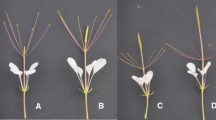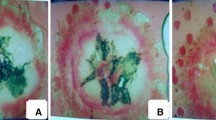Abstract
Argan (Argania spinosa) is an evergreen tree native to southwestern Morocco appreciated for its edible, high nutritional oil, extracted from the kernels of the drupe-like fruit. Aspects of its reproductive biology were studied with the aim to domesticate the tree as an oil crop. Flowering offertigated trees cultivated in the Negev Highlands of Israel was confined to the spring months. The flowers were protogynous. Results of different pollination treatments showed that a pollen vector was necessary for pollination and that fruit set was significantly higher in cross and open pollination (7–9%) than in self pollination (0.5%). The lower fruit set obtained in self pollination was related to postzygotic discrimination. Pollen transfer by wind was restricted to short distances. Flies, mainly of the family Calliphoridae, visited the flowers and were found to be covered with argan pollen. Fruits ripened nine months after anthesis, exhibiting bisigmoidal growth curve.
Résumé
L’arganier (Argania spinosa) est un arbre endémique du Sud-Ouest marocain apprécié pour I’huile comestible et á haute valeur nutritive extraite des graines de son fruit á caractére de faux drupe. Nous avons étudié certains aspects de la biologie reproductive de I’arganier dans le but de domestiquer cet arbre pour son huile. La floraison d’arbres irrigués poussant en Israël dans les hauteurs du Negev est restreinte au printemps. Les fleurs sont protogynes, le style emergeant de la fleur avant I’anthése. Les résultats de différents traitements de pollinisation demontrent la nécessité d’un vecteur pour la pollinisation, et aussi que le nombre de fruits posés est significativement plus élevé dans les cas de croise-ments et de pollinisation ouverte (7–9%) que dans les cas d’auto-pollinisation (0.5%). La reduction ohservée dans le nombre de fruits posés par I’auto-pollinisation est attribuable á une discrimination post-zygotique. Le transport du pollen par le vent est restreint á de courtes distances, et Vintervention de mouches (Calliphoridae) dans la pollinisation a été démontrée. Les fruits exhibent une courbe de croissance bisigmoïde et atteignent I’état mûr neufmois aprés I’anthése.
Similar content being viewed by others
Literature Cited
A.O.A.C. Association of Official Chemists. 1990. Official Methods of Analysis AOAC, 15 Edn. Arlington, Va.
Ascer, P. D., and Peloquin, S. J. 1966. Effect of floral aging on the growth of compatible and incompatible pollen tubes inLolium longiforum. American Journal of Botany 53:92–102.
Belmouden, S., F. Bani Aameur, and P. Dupuis. 1995. Distribution dcs glomérules florifères selon le type de rameaux de l’arganier. Pages 82-83inColloque International: La Forct Face a la Déser-tifaction—Cas des Arganiers. Faculté de Sciences d’Agadir, 26–28 October 1995.
Cornu, M. 1897. Note sur la structure des fruits de l’argan du Maroc (Argania Syderoxylon). Bulletin de la Société Botanique FranÇaise 44:181–187.
Farines, M., J. Soulier, M. Charrouf, and R. Sou-lier. 1984. Étude de l’huile des graines d’Argania spinosa (L.) Sapotaceae. I. La fraction glycéri-diquc. Revue Francise des Corps Gras 31:283–286.
Ferradous, A., F. Bani-Aameur, and P. Dupuis. 1995. Phénologie et fructification de l’arganier. Pages 84–85in Colloque International: La Forêt Face a la Désertifaction—Cas des Arganiers. Faculté de Sciences d’Agadir, 26–28 October 1995.
Huyghebaert, A., and H. Hendricks. 1974. Quelques aspects chimiques physiques et technologiques de l’huile d’argan. Oléagineux 1:29–31.
Irijimovich, V. 1995. Biology of flowering and fruit development of the arganArgania spinosa (L.). M. Sc. thesis, the Faculty of Natural Sciences, Ben Gurion University of the Negev, Beer Sheva, Israel. (In Hebrew).
Leopold, A. C, and P. E. Kreidmann. 1975. Plant Growth and development. McGraw-Hill, New York.
Martin, W. M. 1959. Staining and observing pollen tubes in the style by means of fluorescence. Stain Technology 34:125–128.
Morton, J. F., and G. L. Voss. 1987. The argan tree(Argania syderoxylon, Sapotaceae), a desert source of edible oil. Economic Botany 41:221–233.
Nerd, A., E. Eteshola, N. Borowy, and Y. Mizrahi. 1994. Growth and oil production of argan in the Negev desert of Israel. Industrial Crops and Products 2:89–95.
Nouaim, R., R. Chaussod, A. El-Aboudi, C. Schna-bel, and J. P. Peltier. 1991. L’arganier: essai de synthése dcs connaissances sur cet arbre. Pages 373–388in Groupe d’Étude de L’Arbre, eds., Phy-siologie des Arbres et Arbustes en Zones Arides et Semi-Arides. John Libbey Eurotex, Paris, France.
Perrot, E. 1907. LArgan. Pages 127–158in Les Vé-gétales Utiles de l’Afrique Tropicale FranÇaise. Fasc. 2—Challamel, Paris.
Prendergast, H. D. V., and C. C. Walker. 1992. The argan—multipurpose tree of Morocco. The Kew Magazine 9:76–85.
Shivanna, K. R., and Rangaswamy, N. S. 1992. In vitro germination methods. Pages 9–20in Pollen biology—a laboratory manual. Springer, Berlin.
Author information
Authors and Affiliations
Rights and permissions
About this article
Cite this article
Nerd, A., Irijimovich, V. & Mizrahi, Y. Phenology, breeding system and Fruit development of Argan [Argania spinosa, Sapotaceae] cultivated in Israel. Econ Bot 52, 161–167 (1998). https://doi.org/10.1007/BF02861204
Received:
Accepted:
Issue Date:
DOI: https://doi.org/10.1007/BF02861204




